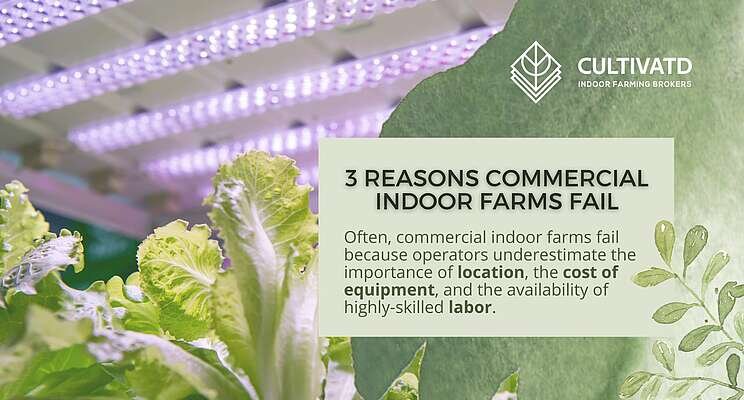3 reasons why commercial indoor farms fail
Added on 25 August 2022

Too often, commercial indoor farms fail because farm operators underestimate the responsibility and cost of establishing and operating their farming facility. The costs most commonly being improperly accounted for are location and highly-skilled labor, as well as equipment purchases and subsequent maintenance.
Reason 1: Poorly Chosen Location For Indoor Farm
Proximity to consumers and the ability to produce crops year-round at a sustainable rate is an important part of what is needed for an indoor farm to be successful. This holds true whether the facility is growing for the food sector or pharmaceutical sector, and it further highlights the need to perform market research to determine: the produce demands of local consumers, the type of facilities and equipment needed to grow crops, and whether there is dependable access to a skilled workforce.
In addition to matching your farm's crop or crops with market demand, it's important to determine how produce will move from your farm, to the packaging facility, to the marketplace. Accounting for this, the farm should be located as close as possible to the community it serves - including distributors, food processors, supermarkets, and local stores. By reducing the amount of transportation needed to deliver food to consumers, marketplace prices are lowered, making the produce more appealing to an increasingly conscientious customer. Furthermore, the reduction in transport costs can offset the production costs driven by the farm's significant energy and labor expenses.
Reason 2: Selecting The Wrong Indoor Farming Equipment
Indoor farms require costly equipment, such as climate controls, shelving units, LED lights, water lines, computers and monitors, and more. It is common for this sizable initial investment to be a significant portion of an indoor farm's startup budget.
"Lighting can account for up to 30% of capital expenditure when setting up a vertical farm and between 25% to 30% of operational costs."
-Mordor Intelligence 2022
Because of the enormity of the financial commitment, it is paramount that farm operators carefully consider the specific needs of their crop/s and carefully select the best solutions for their farm. Without making the effort to determine the exact lighting and environment requirements of their crops, it can be expected that valuable resources - time and money - will be wasted on experimentation in the pursuit of maximum yield and revenue.
Image: Cultivatd
Source: HortiBiz
More news















